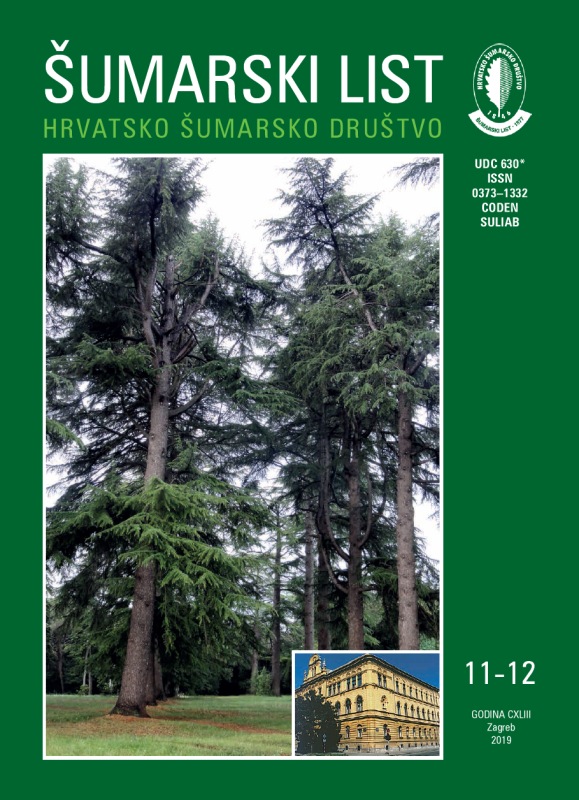
broj: 11-12/2019
pdf (10,71 MB) |
|
||||||||||||||
| RIJEČ UREDNIŠTVA | ||
| Uredništvo | ||
| Should the national forestry policy and strategy be modernized? pdf HR EN | 513 | |
| IZVORNI ZNANSTVENI ČLANCI | ||
| Jurij Marenče, Marijan Šušnjar | UDK 630* 375 (001) https://doi.org/10.31298/sl.143.11-12.1 | |
| Limiting forces and load masses during timber winching pdf HR EN | 515 | |
| Ivan Lukić, Željko Zgrablić, Vlatka Mičetić Stanković | UDK 630* 453 (001) https://doi.org/10.31298/sl.143.11-12.2 | |
| Presence of birch bark beetle (Scolytus ratzeburgi) in Croatia pdf HR EN | 523 | |
| Stjepan Kvesić, Dalibor Ballian, Mirzeta Memišević Hodžić | UDK 630* 164 (001) https://doi.org/10.31298/sl.143.11-12.3 | |
| Population variability of field maple (Acer campestre L.) in Bosnia and Herzegovina according to the fruit morphology pdf HR EN | 529 | |
| Deniz Güney, Zeki Yahyaoglu, Ali Bayraktar, Fahrettin Atar, Ibrahim Turna | UDK 630* 165 (001) https://doi.org/10.31298/sl.143.11-12.4 | |
| Genetic diversity of Picea orientalis (L.) Link populations in Turkey pdf HR EN | 539 | |
| PREGLEDNI ČLANCI | ||
| Ilija Đorđević, Nenad Ranković, Jelena Nedeljković, Jelena Tomićević-Dubljević, Dragan Nonić, Stjepan Posavec, Goran Češljar | UDK 630* 934 + 676 (001) https://doi.org/10-31298/sl.143.11-12.5 | |
| Mechanisms of financing the protected area management system in Serbia pdf HR EN | 549 | |
| PRETHODNO PRIOPĆENJE | ||
| Nikica Ogris, Tine Hauptman, Maarten de Groot, Dušan Jurc | UDK 630* 270 + 305 https://doi.org/10.31298/sl.143.11-12.6 | |
| Comparison of two methods for monitoring urban forests health pdf HR EN | 561 | |
| Ivan Pervan, Tena Radočaj, Tea Tomljanović, Miljenko Bujanić, Dean Konjević | UDK 630* 134 https://doi.org/10.31298/sl.143.11-12.7 | |
| Determination of sex and morphological characteristics of fat dormouse (Glis glis) from the area of Dalmatian hinterland pdf HR EN | 571 | |
| Summary Edible dormouse (Glis glis L.) is the largest dormouse species. The edible dormouse is autochthonous game species in Croatia, and arboreal animal that is active at night. During the hunting season 2017./2018. we have collected 32 adult individuals (18 females and 14 males), on the area Dalmatian hinterland. Following sex determination, the following morphological parameters were measured: mass (total mass including tail, total mass without tail , head, tail, liver, kidney, heart, lung, digestive system and radman) and body length measurements (body length including tail, body length without tail, front and back width of the puck and tail length). Statistically significant difference between males and females was found in the length of the body without the tail (p = 0.049) and tail mass (p = 0.041), with males displaying greater values for both of these features. The other measured parameters did not show significant differences between sexes. Sexual dimorphism in this rodent is not pronounced, though on average males tend to be larger and heavier than females. It was not possible to differentiate adults and juveniles based on the color of the fur and the body size. Measured morphological parameters mostly coincide with results of similar research. Edible part of internal organs constitutes 5.1% of live weight (heart and lungs 1.8%, livers 2.43% and kidneys 0.8%). Non-edible part includes stomach and intestines (12.3%), head (11.78%), tail (4%) and skin and metapodia (11.21%). Sex of an individual Edible dormouse can be safely determined by looking at the external sex organs. Body length and total mass of Edible dormouse in Dalmatian hinterland is similar to the population in the Gorski Kotar region. Although we have established a statistically significant difference in the length of the body without the tail and the mass of the tail of the males compared to the same indicators in females, they are not sufficient for the use in recognizing sex of Edible dormouse. Key words: Edible dormouse (Glis glis L.); Dalmatian hinterland; morphology; sexual dimorphism | ||
| STRUČNI ČLANCI | ||
| Damir Drvodelić, Milan Oršanić | UDK 630* 232 https://doi.org/10.31298/sl.143.11-12.8 | |
| Selecting high quality forest seedlings of narrow-leaved ash (Fraxinus angustifolia Vahl) for regeneration and reforestation purposes pdf HR EN | 577 | |


